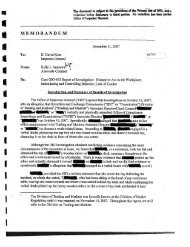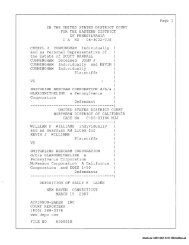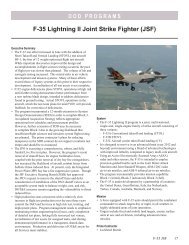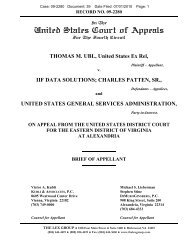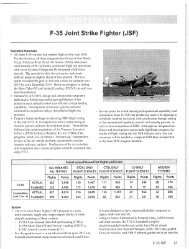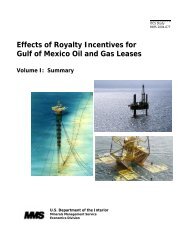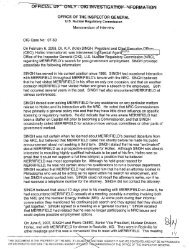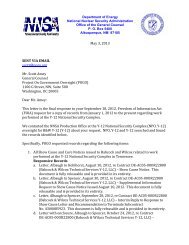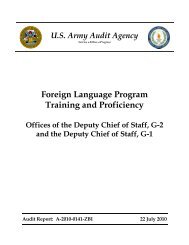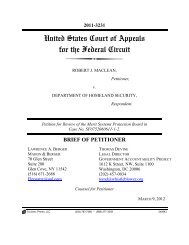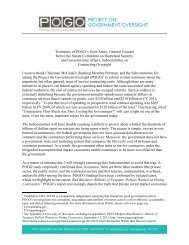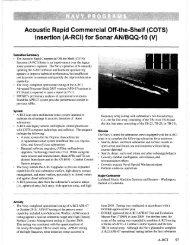F-35 Joint Strike Fighter (JSF)
F-35 Joint Strike Fighter (JSF)
F-35 Joint Strike Fighter (JSF)
Create successful ePaper yourself
Turn your PDF publications into a flip-book with our unique Google optimized e-Paper software.
• The government-contractor test team attempted test points<br />
in up-and-away flight envelope expansion. STOVL-mode<br />
flight, handling qualities, propulsion testing and readiness<br />
for the first ship integration test period (planned for<br />
late 2011).<br />
• In FY 10. STOVE Flight Sciences aircraft flew 130 of 173<br />
planned sorties; the test team completed 1,467 of l,678<br />
planned test points. However, the test team accomplished<br />
only 10 of 42 planned vertical landings between March and<br />
November 2010; these are key to the shore-based build-up<br />
to testing on L-class amphibious ships at sea, In the first<br />
two months of FYI l, STOVE flight sciences aircraft flew<br />
54 sorties. 5 more than planned; the test team accomplished<br />
<strong>35</strong>6 of 506 planned test points, From mid-August<br />
until early November, the test team flew CTOL-mode<br />
configurations due to limitations of the vertical-lift<br />
capability of the STOVL system. STOVE-mode flight test<br />
operations began again in BF-1 in November 2010,<br />
• In July, the program made changes to supply chain<br />
management to provide timely spares and implemented<br />
surge scheduling and 7-day/week maintenance operations,<br />
These actions contributed to an increase in flights per month<br />
of approximately 25 percent.<br />
• Discoveries during STOVL Flight Sciences testing this<br />
fiscal year include transonic wing roll-off, greater than<br />
expected sideslip during medium angle-of-attack testing,<br />
higher and unanticipated structural loads on STOVL doors,<br />
and poor reliability and maintainability of key components.<br />
CTOL Hight Sciences, night Test with AF-1 and A F-2 Test<br />
Aircraft<br />
• AF-1 and AF-2 ferried to Edwards AFB. California, in May.<br />
as planned.<br />
• Maintenance, test operations, and engineering staffs<br />
increased significantly (approximately 50 percent) in FY10.<br />
The program intends to reach full strength in 2011, pending<br />
hiring of qualified contractor personnel.<br />
• In FY 10, the test team made progress in envelope<br />
expansion, handling qualities, and propulsion test points.<br />
CTOL Flight Sciences aircraft flew 111 sorties, 6$ more<br />
than planned. The test team completed 963 test points,<br />
exceeding the 485 planned flight test points for the fiscal<br />
year. In the first two months of FY11, CTOL flight sciences<br />
aircraft flew 44 sorties, 18 more than planned; the test team<br />
accomplished 331 4340 planned test points.<br />
• The program anticipates the remaining CTOL Flight<br />
Sciences aircraft, AF-4, will ferry to Edwards, AFB,<br />
California. by January 2011, approximately two months<br />
later than planned.<br />
• Discoveries during CTOL flight sciences flight test in this<br />
fiscal year include transonic wing roll-off, greater than<br />
expected sideslip during medium angle-of-attack testing,<br />
and problems with reliability and maintainability of key<br />
components.<br />
CV Flight Sciences, Flight Test with CF-1 Test Aircraft<br />
CF- I flew for the first time in June 2010. The aircraft<br />
ferried to Patuxent River NAS, Maryland, in early<br />
November 2010, one month later than planned.<br />
• While at Fort Worth. Texas, CF- 1 flew airworthiness<br />
and initial-service-release propulsion system test flights,<br />
accomplishing 14 flight test sorties, five more than planned.<br />
As a result, CF-1. flew 344 test points, significantly more<br />
than the 77 planned for the fiscal year. In the first two<br />
months of FY II. aircraft CF-1 flew 10 of 12 planned<br />
sorties; the test team accomplished 4 of 14 planned test<br />
points.<br />
• The Integrated Test Force at Patuxent River NAS,<br />
Maryland, built up maintenance and engineering support<br />
personnel in anticipation of the arrival of CF-1, which the<br />
program delivered to the test center in November 2010.<br />
• The program anticipates the remaining CV flight<br />
sciences test aircraft, CF-2 and CF-5. will ferry to<br />
Patuxent River NAS. Maryland, in February 2011 and<br />
late 2013. respectively. Aircraft CF-2 would then arrive<br />
approximately two months later than planned.<br />
Mission Systems, 13F-4 and A F-3 Right Tests and Software<br />
Development Progress<br />
• Block 0.5 Infrastructure<br />
- The program released Block 0.5 software for flight<br />
test in March 2010, five months later than planned.<br />
The software had completed mission systems lab<br />
integration activity and integration flights on the<br />
Cooperative Avionics Test Bed (CATB). Block 0.5<br />
is the infrastructure increment, which contains<br />
communications, navigation, and limited radar<br />
functionality.<br />
Aircraft BF-4, loaded with Block 0.5, accomplished first<br />
flight in April 2010, five months later than planned, and<br />
then ferried to Patuxent River NAS, Maryland, in June,<br />
two months later than planned, and began Block 0.5<br />
flight test.<br />
Test teams attempted approximately 70 percent of the<br />
planned Block 0.5 flight test points on BF-4. Software<br />
problems occurring before and during flight test were<br />
not resolved in the Block 0,5 configuration. Program<br />
leadership deemed Block 0.5 unsuitable for initial<br />
training and adjusted the software development plan to<br />
implement fixes for the Block 0.5 problems in the initial<br />
release of Block flle integrated test force is re-flying<br />
selected Block 0.5 flight test points in the Block 1<br />
configuration.<br />
• Block I, Initial Training Capability<br />
- The program delivered aircraft AF-3 in a Block 1<br />
configuration to Edwards AFB, California, in December<br />
2010, approximately five months later than planned.<br />
- The program intends the Block I design (which includes<br />
multi-sensor fusion capability) to support the initial<br />
F-<strong>35</strong> <strong>JSF</strong> 15



